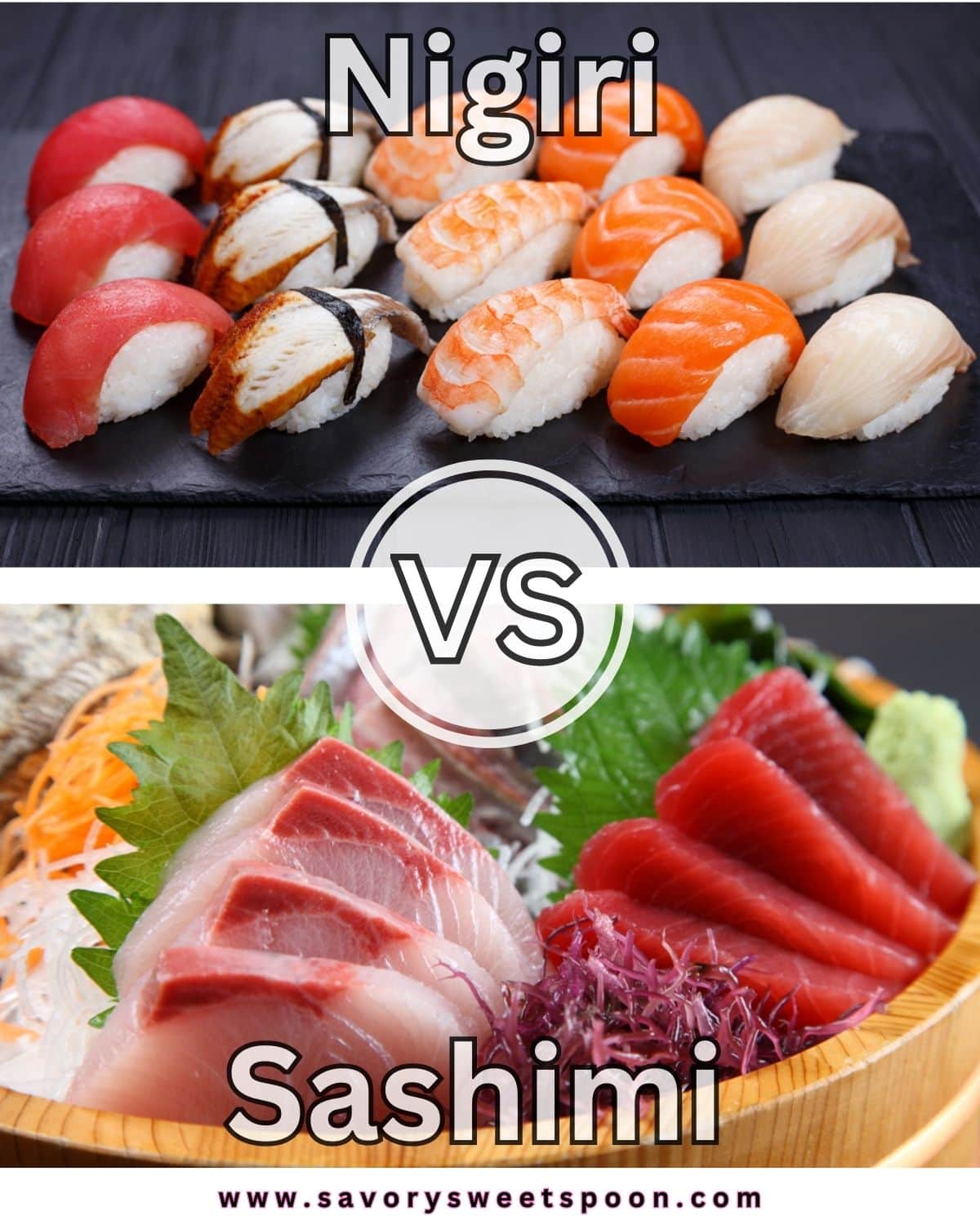Nigiri vs. Sashimi: What is the difference?
If you’ve ever found yourself puzzled by the distinctions between nigiri vs sashimi while dining at a traditional Japanese restaurant, I’ve got you covered! This comprehensive guide is here to equip you with the knowledge to appreciate the nuanced differences between these two iconic dishes.

Whether you’re a curious food enthusiast or a passionate sushi lover, understanding the contrast between nigiri and sashimi will deepen your appreciation for the artistry and tradition that underpin Japanese culinary heritage. So, let’s discover what sets them apart.
What is Nigiri?
Nigiri is a type of sushi that originated in Japan. It consists of a small mound of sushi rice that is hand-formed into an oblong shape and topped with a slice of raw or cooked seafood. The seafood commonly used for nigiri includes fish such as tuna, salmon, yellowtail, and shrimp, although other ingredients like octopus, eel, and tamago (sweet omelet) can also be used.

The sushi rice used in nigiri is seasoned with a mixture of rice vinegar, sugar, and salt, which gives it a slightly tangy and sweet flavor. The rice is typically pressed firmly to hold its shape and to create a contrast in texture with the topping.
Nigiri is often served with a small amount of wasabi (Japanese horseradish) placed between the rice and the seafood, although some variations may have the wasabi already mixed into the rice. It is traditionally enjoyed by dipping the fish side into a small dish of soy sauce before eating.
Nigiri is a popular and widely recognized form of sushi, appreciated for its simplicity and focus on showcasing the quality of the seafood.
What is Sashimi?
Sashimi is a Japanese delicacy consisting of thinly sliced raw seafood or occasionally, other types of meat. Unlike sushi, sashimi does not include rice or other ingredients. The focus of sashimi is solely on the high-quality, fresh ingredients.

Typically, sashimi is made from seafood such as tuna, salmon, yellowtail, octopus, scallops, or sea bream. It can also include other ingredients like squid, shrimp, or even non-seafood options like beef or horse meat, though the latter are less common.
The key to sashimi is the freshness and quality of the ingredients. The seafood is sliced into thin pieces, often with skilled precision, to enhance its natural texture and flavor. The slices are usually presented in an artful arrangement on a plate, often accompanied by garnishes like shredded daikon radish, shiso leaves, or seaweed.
When served, sashimi is typically enjoyed with soy sauce and wasabi. The soy sauce is used as a dipping sauce, and a small amount of wasabi is either added to the soy sauce or placed directly on the sashimi slices before being dipped. However, the amount of wasabi used is a matter of personal preference.
Sashimi is highly regarded for its simplicity and purity, allowing the natural flavors and textures of the seafood or meat to shine. It is commonly found in Japanese cuisine and enjoyed as a standalone dish or as part of a larger meal.
Nigiri vs Sashimi

Ingredients:
- Nigiri: Nigiri consists of sushi rice topped with a slice of raw or cooked seafood, typically fish, although other ingredients like eel or tamago (sweet omelet) can also be used.
- Sashimi: Sashimi is thinly sliced raw seafood or occasionally other types of meat, served without rice or additional ingredients.
Rice:
- Nigiri: Nigiri includes sushi rice that is seasoned with vinegar, sugar, and salt. The rice is hand-formed into a small oblong shape and serves as the base for the topping.
- Sashimi: Sashimi does not include rice. It focuses solely on the raw seafood or meat slices.
Presentation:
- Nigiri: Nigiri is presented as a small mound of rice topped with a slice of seafood. It often features an artful arrangement and can be garnished with ingredients like seaweed.
- Sashimi: Sashimi is typically presented as thinly sliced seafood or meat, arranged in an aesthetically pleasing manner on a plate. It may be accompanied by garnishes like shredded daikon radish or shiso leaves.
Consumption:
- Nigiri: Nigiri is typically eaten with chopsticks. It can be dipped into soy sauce and enjoyed in a single bite, with the fish side down to enhance the flavors.
- Sashimi: Sashimi is also eaten with chopsticks. It can be dipped into soy sauce mixed with wasabi or enjoyed plain, allowing the natural flavors of the seafood or meat to be savored.
Purpose:
- Nigiri: Nigiri is a type of sushi that combines the flavors of rice and seafood. It aims to provide a balanced and harmonious combination of textures and tastes.
- Sashimi: Sashimi focuses on the purity and freshness of the seafood or meat, allowing its natural flavors and textures to take center stage without the addition of rice or other ingredients.







